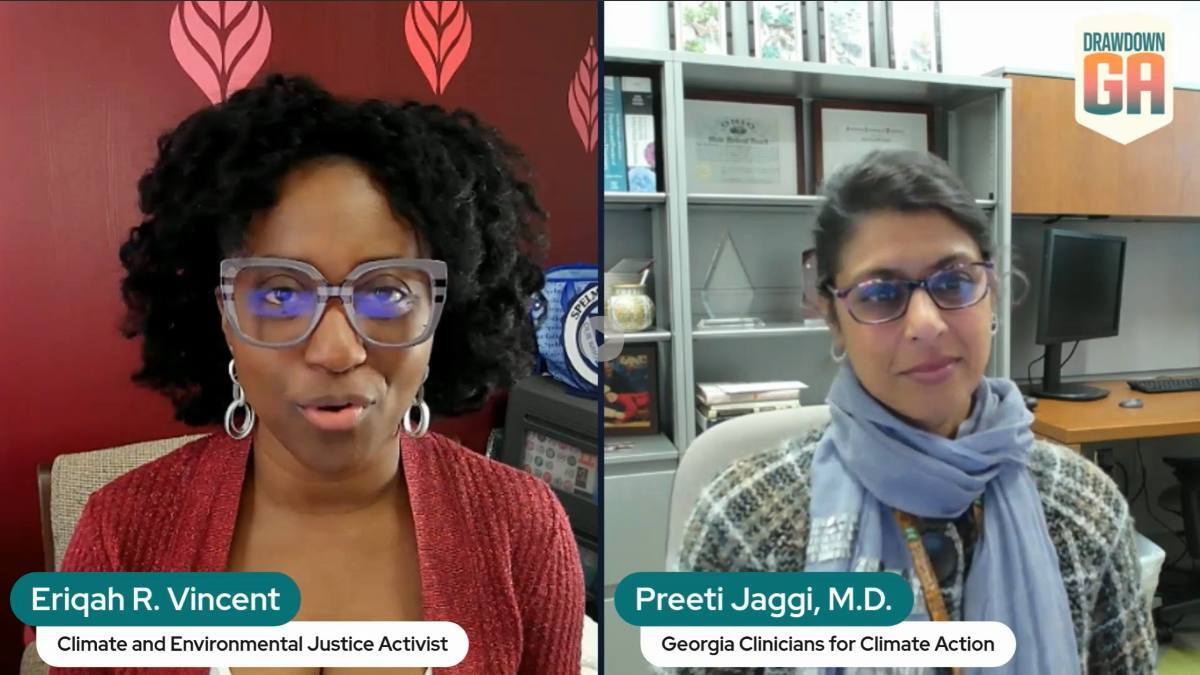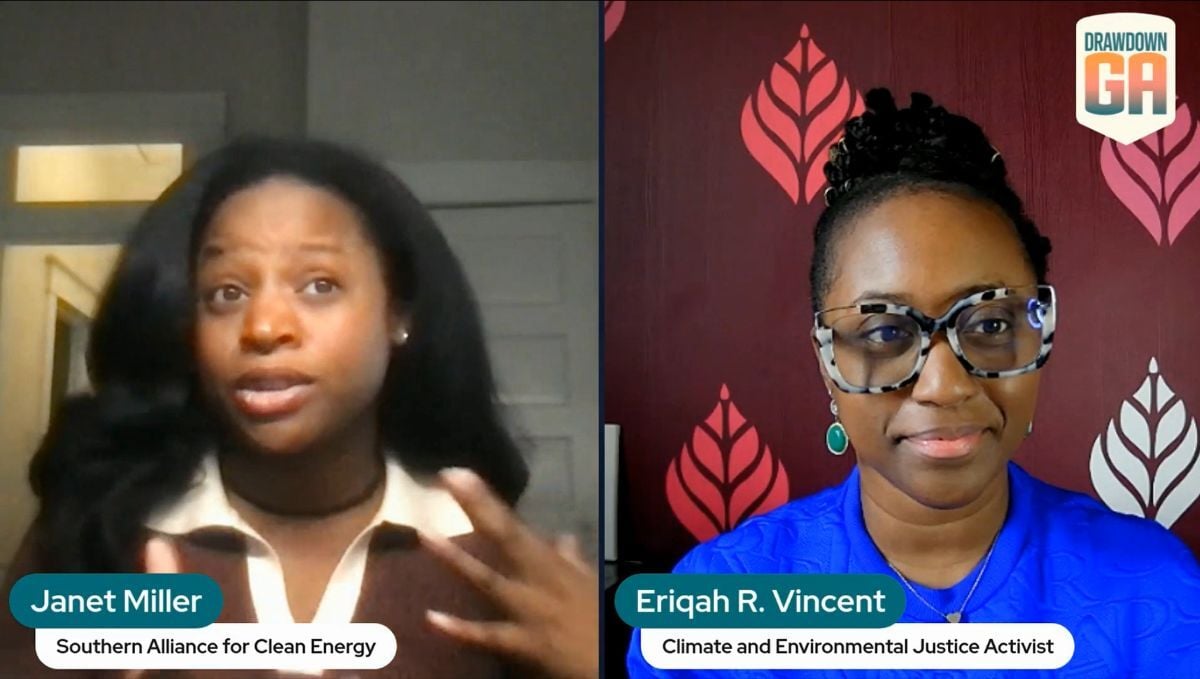Electric Vehicles are growing rapidly as a climate solution in Georgia. How do we ensure that the benefits of EVs are available to all Georgians? What is the truth behind some of the misconceptions about electric vehicles? And when you are ready to upgrade to an EV, where can you find answers to common questions about the differences between EVs and gas cars?
You’ll find the answers to all of these questions and more in this interview in the Georgia Climate Digest video series with Eriqah Vincent of Drawdown Georgia and Dory Larsen of the Southern Alliance for Clean Energy (SACE).
Dory also shares why she loves driving electric and explores the many important e-mobility equity initiatives currently underway at SACE.
Electric Vehicles Interview and Highlights
Highlights:
Dory dives into the numbers around the economic impact of EV manufacturing in Georgia. [5:57 - 9:14]
An overview of SACE’s Electric Black Futures project, which seeks to expand equitable e-mobility in three Georgia cities. [10:37 - 12:55]
Hear more about the EV toolkit Dory co-authored for Drawdown Georgia and why you should check it out. [19:38 - 22:23]
Dory breaks down some of the common misconceptions about EVs. [23:25 - 25:38]
A lightly edited transcript follows:
Dory Larsen of the Southern Alliance for Clean Energy Discusses EVs
Eriqah Vincent: I am delighted to be joined today by Dory Larson with the Southern Alliance for Clean Energy. I would love for you to start by telling us more about yourself and, of course, the work you do with SACE.
Dory Larsen: My educational background is in public health. I earned a master's degree in public health from the University of South Florida, and I've also been a public educator for over ten years.
While I was teaching, I started doing some grassroots organizing, leading a community fight to stop development on 75 acres in my hometown. That taught me the power of people collectively working together towards a shared vision. It also made me realize that while habitat preservation is something I'm really passionate about, it opened my eyes to the importance of clean energy solutions. I always tell my boys, "You don't know what you don't know until you learn it, and then you do better." So that's what brought me into the fold at the Southern Alliance for Clean Energy.
Eriqah: I was an intern at SACE in 2011, so I am familiar with the work that SACE does, but maybe our audience would like to know what SACE is about as an organization.
Dory: We advocate for responsible and equitable energy production and consumption in the Southeast, and we define the region geographically as Tennessee, North and South Carolina, Georgia, and Florida, so we have quite a big footprint in the Southeast.
The Air Quality Benefits of Electric Vehicles
Eriqah: What brought you to work in the field of electric transportation specifically? And why are you so passionate about the sector as a climate solution in our region?
Dory: When I started with SACE in 2017, the industry was in its infancy, so it's been a lot of fun to grow with the industry. I'm really passionate about electric transportation as a climate solution because it's something that I think we all can relate to.
We've all been stuck in traffic behind a truck or a bus that is spewing tailpipe emissions, and we all have that very visceral response: our eyes watering, our throat being scratchy. We all know how bad fossil fuel-burning vehicles make us feel. But not everybody understands that electric vehicles don't have a tailpipe, so they're not burning those poisonous gasses and pumping them out into our communities.
If you look at car commercials, you've got these happy people going to these pristine forests or on these adventures, but you're never going to see an ad depicting a child in a hospital room in crisis because of an asthma attack, because of the unhealthy air that she's been breathing on her diesel bus ride to school. And you're certainly never going to see imagery that helps our communities understand that it's impacting Black communities and under-resourced communities at far higher rates.
There are two big reasons why I’m so passionate about electrifying all of our transportation systems:
-
One is the immediate improvement in air quality, especially for those that are most vulnerable.
-
And two, it's a long-term climate solution to draw down carbon levels that exacerbate other dangers like extreme heat and rapidly escalating storms and flooding.
Eriqah: I love it when we have these types of conversations because we are doing the work of making sure that the movement is intersectional. Clean energy is not devoid of environmental justice--it all has to be connected if it's going to be its most meaningful and its most impactful.
Economic Benefits of Electric Vehicle Investments in Georgia
Let's talk a little bit about Georgia's outsized influence in the EV transition, given the significant investments being made around manufacturing in the state. Can you talk a little bit about that and how it is impacting the region from an economic and policy perspective?
Dory: Another exciting piece to the story is that, in addition to the health and climate benefits of electric transportation investments, we're also seeing this spurring the economy in Georgia. Over 26,000 new jobs in the private sector around electric vehicle manufacturing and battery manufacturing have been added since November 21st, which is when the Bipartisan Infrastructure Law was passed.
Georgia is the undisputed national leader in the electric motor sector. Currently, Georgia leads the nation in committed investments and in permanent jobs in EV and battery manufacturing. That's outpacing every other state in the country, including Michigan.
This number is crazy: through Q2 of 2024, $23.2 billion has been invested in Georgia as a direct result of the Bipartisan Infrastructure Law and the Inflation Reduction Act. Those bills were passed and designed to transition American manufacturing away from polluting fossil fuel vehicles to cleaner, efficient electric vehicles.
One example is the $7.6 billion Hyundai metaplant, an assembly plant in Ellabell, which is projected to create over 2,000 construction jobs and 8,500 permanent jobs. They're going to be building over 300,000 vehicles annually. They've also entered an MOU with Savannah Technical College to provide training jobs related to shop operations, electrical principles, and also servicing electric vehicles.
There are similar programs throughout the state at Columbus and Augusta Technical Colleges. The intent is for these newly trained workers to support the growing manufacturing sites.
Electric Vehicles and Climate Justice Initiatives in Georgia
Eriqah: Thank you so much for adding context around those numbers. I think there is a misconception that there isn't a lot that we can do around clean energy and climate justice in this region. It's always good for us to hear that these developments exist in a place like Georgia.
How is SACE taking action to support e-mobility equity in the Southeast?
Dory: SACE is working on a number of initiatives in this area.
Electric Black Futures
I’ll start with Electric Black Futures.
We’re partnering with EVNoire, Clean Cities Georgia, and a host of other local partners to engage Black communities in Albany, Atlanta, and Savannah over the next three years to create opportunities for these communities to shape their e-mobility future.
It's designed to inform and support the deployment of electric transportation-related Bipartisan Infrastructure Bill and Inflation Reduction Act funds, making sure that they're in line with Justice40 guidelines. If listeners aren't familiar with Justice40, for the first time in our nation's history, the federal government has made it a goal that 40% of the overall benefits of certain federal investments flow to disadvantaged communities that are marginalized by underinvestment and also overburdened by pollution.
It's a paradigm shift, and it is exciting to see that funding is going to communities that are impacted the most and need the most support. We're going to work closely with those communities to generate future-building coalitions focused on bridging e-mobility workforce and leadership opportunities. The objective is to strategize and document equitable and innovative transportation systems in those three geographies that will better connect Justice40 benefits to community leaders who are eager to lead technological developments in their areas.
Electrify the South Collaborative
We have the Electrify the South Collaborative, which is a partnership between SACE and the Southeast Sustainability Directors Network, or SSDN.
We're working with local governments to support them in accessing and implementing federal electric transportation funding. We're convening in-person and virtual meetings that are building capacity through peer-to-peer learning and resource sharing and also building connections to technical assistance. Part of that work is building local governments' capacity and capabilities to integrate those Justice40 guidelines into the projects that I mentioned.
Electric School Buses
We're also doing electric school bus work in collaboration with stakeholders from the Environmental Protection Agency’s Clean School Bus Program, World Resources Institute, the Alliance for Electric School Buses, Mothers and Others for Clean Air, and many other partners to accelerate school bus electrification in the Southeast.
There's still so much work to do to educate superintendents and school board members about the benefits of electric school buses and about the programs and the funding that's available. We’re focused on making sure that we prioritize bus routes to overburdened neighborhoods so that the students and communities that are most impacted are getting direct benefits from the program.
Clean Energy Generation
Last of all is SACE’s Clean Energy Generation, which has a double meaning referencing both generating clean energy, but also working together across generations to create a movement of people that are advocating for clean energy solutions and energy justice. They're learning together about opportunities and also taking action.
The Clean Energy Generation highlights stories about individuals making a difference. For example, we have a story about Olivia from Cleveland, Georgia, who has her own solar installation business and workforce center, and she's training workers with diverse backgrounds. It’s all about making sure that we're working collectively to tell those really important stories.
The Clean Energy Generation meets virtually on the second Friday of every month. There's a newsletter that goes out and they do monthly advocacy opportunities. This month, they are calling used car dealerships to make sure that they're aware of the federal tax credits and then giving that information back to a national database so that we're helping to inform consumers about those tax credits and making sure that opportunity is well known.
Eriqah: So much great equity work happening in the EV space. I'm really glad to hear that there's intentional work happening to make sure that those communities are not left out.
Drawdown Georgia Toolkit: How to Upgrade to an Electric Vehicle
So switching gears a little bit, you co-authored the Drawdown Georgia’s How to Switch To An Electric Car in Georgia toolkit. Tell us more about it and why Georgians should take a look.
Dory: It was a lot of fun to put together.
Transportation is the leading cause of greenhouse gasses being added to the atmosphere. If you live near a highway, you're more at risk, so it's on all of us to understand the benefits of electric transportation as a solution and be supportive of policies that can rapidly transition us to electric transportation. Even if you're not in the market right now for an electric vehicle, you can use the toolkit to become better educated about the benefits of electric mobility.
You can then advocate and let your elected officials know that you support them transitioning the transit buses to electric, school buses to electric, and the light-duty fleet as well, and educate them on the importance of community charging and that there are tax credits to support that work.
You can also vote for elected officials that are supportive of clean energy solutions like transportation electrification.
It's also useful if you are looking to educate yourself because you're ready to purchase a new vehicle. The toolkit explains all of the baseline things that you would need to familiarize yourself with before you buy an electric vehicle. It explains the cost of charging, how to charge, and where to find the charging stations using apps.
It describes all of the different aspects of EV ownership. The toolkit includes resources like Plug In America, which is a great consumer organization with information to help you find the best vehicle for you. You can plug in your zip code and it'll tell you about incentives that are available locally.
Addressing Common Misconceptions about Electric Vehicles
Eriqah: We hear a lot about electric vehicles, including some misinformation about them. What are the misconceptions about electric vehicles?
Dory: The one that really gets me is that EVs are just as bad for emissions as a gas car. I think what annoys me the most about it is that the people pushing this myth are trying to get folks to feel apathy and create confusion about whether or not EVs are a better solution.
Obviously, there are going to be some emissions from driving electric cars because you have to generate electricity to power the car, but there are far fewer emissions than a gas car. And that's because an electric motor is a lot more efficient, so it's using a lot less energy to go from point A to point B.
The Department of Energy publishes emissions data and it updates that data every year based on how electricity is being generated. Right now, an EV annually emits 2,446 pounds of carbon dioxide. That's compared to 12,594 pounds annually with an internal combustion engine. That's 81% fewer emissions.
What's also interesting is that when we published the toolkit and we looked at Georgia-specific data, that number was only 70% fewer emissions for EVs. So in just the past few years, because energy generation is getting cleaner as we're moving away from fossil fuels, that makes our transportation systems cleaner as well. That trend is going to continue as we add more renewable energy to our power grid.
EVs have much lower lifecycle emissions, too. The biggest part of the carbon footprint associated with an electric vehicle is making the battery. That's the most carbon-intensive part of it if you look at the whole lifecycle. So because of this, EVs are more carbon intensive until around 15,000 miles. After 15,000 miles, the total carbon footprint becomes far less than an internal combustion or gas car. We have the ability to reduce that battery production footprint by 75% in the next 5 to 7 years. So EVs are clearly a winning solution to reducing planet climate pollution.
Why Dory Larsen Loves Driving Electric
Eriqah: What is your favorite thing about driving an electric vehicle?
Dory: It's like going from a flip phone to a smartphone. When you hit the accelerator, the car takes off and goes. It’s also so much more convenient to never have to go to a gas station. I can just drive home, plug in, and charge at night while I'm sleeping.
It's like a third of the cost, the electricity cost versus gas costs, so it's a far cheaper way to fuel your vehicle.
Eriqah: I've also heard that there's not as much maintenance. Do you find that the maintenance costs are less, or fewer and further between with an electric vehicle?
Dory: Yes. Electric vehicles have fewer moving parts, so there are fewer things to go wrong. There's no timing belts, there's no oil. That's a surprise to some people. So yes, the maintenance savings and the fuel savings are part of the reason why, when you look at the total cost of owning an electric vehicle, even if the purchase price is a little bit more than a gas car, the total cost of ownership is frequently lower with an electric car. You're not paying as much for routine maintenance.
Eriqah: This has been really eye-opening for me. This is certainly not my wheelhouse, but I do love talking about electric cars because I'm fascinated by the ways that they work, and the ways in which we are including everyone in those conversations, even folks who don't own electric cars themselves.
What’s Giving Dory Hope Around EVs as a Climate Solution in Georgia
We ask this question to all of our guests: What's giving you hope around climate solutions, especially climate solutions in Georgia?
Dory: What gives me hope is that the solutions are here today. We just need to continue to work and make it happen.
Globally, the sales of internal combustion engines peaked around 2017, and electric vehicle sales accounted for 10% of new car purchases in the U.S. last year. It's going to take some time as people still continue driving gas cars, but we're starting to see that inflection point.
EVs could make up almost a third of new car sales by 2027, according to Bloomberg New Energy Finance's latest electric vehicle outlook. Raising consciousness about the benefits and more people switching than ever are two things that I'm really hopeful about.
Eriqah: Thank you so much to Dory and Southern Alliance for Clean Energy, not only for being with us today for the work that you're doing when it comes to electric transportation.
Subscribe for Future Interviews + Insights on Climate Solutions in Georgia
Subscribe now to the Georgia Climate Digest to receive this and future Georgia Climate Digest video interviews right in your inbox, along with updates about our progress on climate solutions. Click the button below to subscribe.









